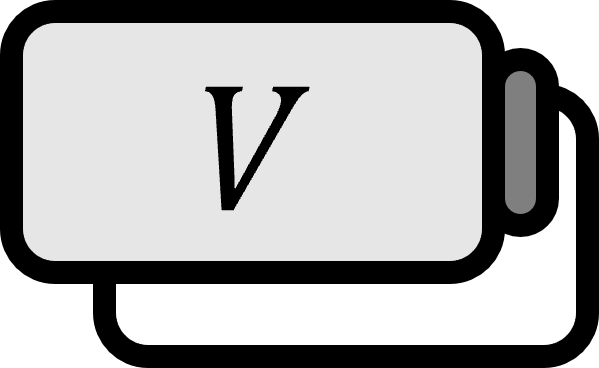이차형식
정의
$V$를 $n$차원 벡터공간이라 하자. 주어진 상수 $a_{ij} \in \mathbb{R}(\text{or } \mathbb{C})$에 대해서, 다음과 같은 2차 동차함수 $A : V \to \mathbb{R}(\text{or } \mathbb{C})$를 이차형식quadratic form이라 한다.
$$ A(\mathbf{x}) := \sum\limits_{i,j=1}^{n} a_{ij}x_{i}x_{j},\qquad (a_{ij} = a_{ji}) $$
이때 $\mathbf{x} = \begin{bmatrix} x_{1} & \cdots & x_{n} \end{bmatrix}^{T}$이다. $i \ne j$에 대한 $a_{ij}x_{i}x_{j}$를 혼합항cross product terms이라 한다.
설명
정의에 따라 $A(\lambda \mathbf{x}) = \lambda^{2} A(\mathbf{x})$가 성립한다.
행렬 꼴
$A$를 $n\times n$ 대칭행렬 $A = \begin{bmatrix} a_{ij} \end{bmatrix}$라고 하자. 행렬 $A$에 대한 이차 형식을, Quadratic의 앞글자를 따서, $Q_{A}(\mathbf{x})$로 표기하고 $A$에 연관된 이차 형식quadratic form associated with A이라 부른다.
$$ Q_{A}(\mathbf{x}) = \mathbf{x}^{T}A\mathbf{x} =\begin{bmatrix} x_{1} & \cdots &x_{n} \end{bmatrix} \begin{bmatrix} a_{11} & \cdots & a_{1n} \\ \vdots & \ddots & \vdots \\ a_{n1} & \cdots & a_{nn} \end{bmatrix} \begin{bmatrix} x_{1} \\ \vdots \\ x_{n} \end{bmatrix}=\sum \limits _{i=1} ^{n}\sum \limits _{j=1} ^{n}a_{ij}x_{i}x_{j} $$
예로 $\mathbb{R}^{2}$상의 이차 형식은 다음과 같다.
$$ \begin{align*} & a_{11}^{\ }x_{1}^{2} + a_{22}^{\ }x_{2}^{2} + a_{12}^{\ }x_{1}^{\ }x_{2}^{\ } + a_{21}^{\ }x_{2}^{\ }x_{1}^{\ } \\ =&\ a_{11}^{\ }x_{1}^{2} + a_{22}^{\ }x_{2}^{2} + 2a_{12}^{\ }x_{1}^{\ }x_{2}^{\ } \end{align*} $$
$\mathbb{R}^{3}$상의 이차 형식은 다음과 같다.
$$ a_{11}^{\ }x_{1}^{2} + a_{22}^{\ }x_{2}^{2} + a_{33}^{\ }x_{3}^{2} + 2a_{12}^{\ }x_{1}^{\ }x_{2}^{\ } + 2a_{13}^{\ }x_{1}^{\ }x_{3}^{\ } + 2a_{23}^{\ }x_{2}^{\ }x_{3}^{\ } $$
중복을 피하기 위해 위와 같이 혼합항을 결합해서 적는 것이 일반적이다. 이차 형식은 행렬 내적의 성질에 의해 다음과 같이 나타낼 수 있다. 실수, 복소수에 대해서 각각 다음과 같다.
$$ \begin{align*} Q_{A}(\mathbf{x}) &= \mathbf{x}^{T} A \mathbf{x} = \mathbf{x} \cdot A\mathbf{x} = A\mathbf{x} \cdot \mathbf{x} = \left< A\mathbf{x}, \mathbf{x}\right> = \left< \mathbf{x}, A \mathbf{x} \right> \\ Q_{A}(\mathbf{x}) &= \mathbf{x}^{\ast} A \mathbf{x} = \mathbf{x} \cdot A\mathbf{x} = A\mathbf{x} \cdot \mathbf{x} = \left< A\mathbf{x}, \mathbf{x}\right> = \left< \mathbf{x}, A \mathbf{x} \right> \end{align*} $$
$A$가 대각행렬일 경우에는 $a_{ij}=0 (i \ne j)$이므로 이차 형식 $Q_{A}(\mathbf{x})$는 혼합항을 가지지 않는다.
$$ Q_{A}(\mathbf{x}) = \mathbf{x}^{T}A\mathbf{x} =\begin{bmatrix} x_{1} & \cdots &x_{n} \end{bmatrix} \begin{bmatrix} a_{11} & 0 & \cdots & 0 \\ 0 & a_{22} & \cdots & 0 \\ \vdots & \vdots & \ddots & \vdots \\ 0 & 0 & \cdots & a_{nn} \end{bmatrix}\begin{bmatrix} x_{1} \\ \vdots \\ x_{n} \end{bmatrix}=\sum \limits _{i=1}^{n} a_{ii}x_{i}^{2} $$

 저희들의 저서 「줄리아 프로그래밍」이 2024 세종도서 학술부문에 선정되었습니다!
저희들의 저서 「줄리아 프로그래밍」이 2024 세종도서 학술부문에 선정되었습니다!

